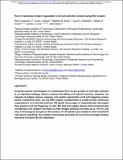Role of nanoscale antigen organization on B-cell activation probed using DNA origami
Author(s)
Veneziano, Rémi; Moyer, Tyson J; Stone, Matthew B; Wamhoff, Eike-Christian; Read, Benjamin J; Mukherjee, Sayak; Shepherd, Tyson R; Das, Jayajit; Schief, William R; Irvine, Darrell J; Bathe, Mark; ... Show more Show less
DownloadSubmitted version (6.685Mb)
Publisher Policy
Publisher Policy
Article is made available in accordance with the publisher's policy and may be subject to US copyright law. Please refer to the publisher's site for terms of use.
Terms of use
Metadata
Show full item recordAbstract
© 2020, The Author(s), under exclusive licence to Springer Nature Limited. Vaccine efficacy can be increased by arraying immunogens in multivalent form on virus-like nanoparticles to enhance B-cell activation. However, the effects of antigen copy number, spacing and affinity, as well as the dimensionality and rigidity of scaffold presentation on B-cell activation remain poorly understood. Here, we display the clinical vaccine immunogen eOD-GT8, an engineered outer domain of the HIV-1 glycoprotein-120, on DNA origami nanoparticles to systematically interrogate the impact of these nanoscale parameters on B-cell activation in vitro. We find that B-cell signalling is maximized by as few as five antigens maximally spaced on the surface of a 40-nm viral-like nanoparticle. Increasing antigen spacing up to ~25–30 nm monotonically increases B-cell receptor activation. Moreover, scaffold rigidity is essential for robust B-cell triggering. These results reveal molecular vaccine design principles that may be used to drive functional B-cell responses.
Date issued
2020Department
Massachusetts Institute of Technology. Department of Biological Engineering; Koch Institute for Integrative Cancer Research at MIT; Massachusetts Institute of Technology. Department of Materials Science and EngineeringJournal
Nature Nanotechnology
Publisher
Springer Science and Business Media LLC